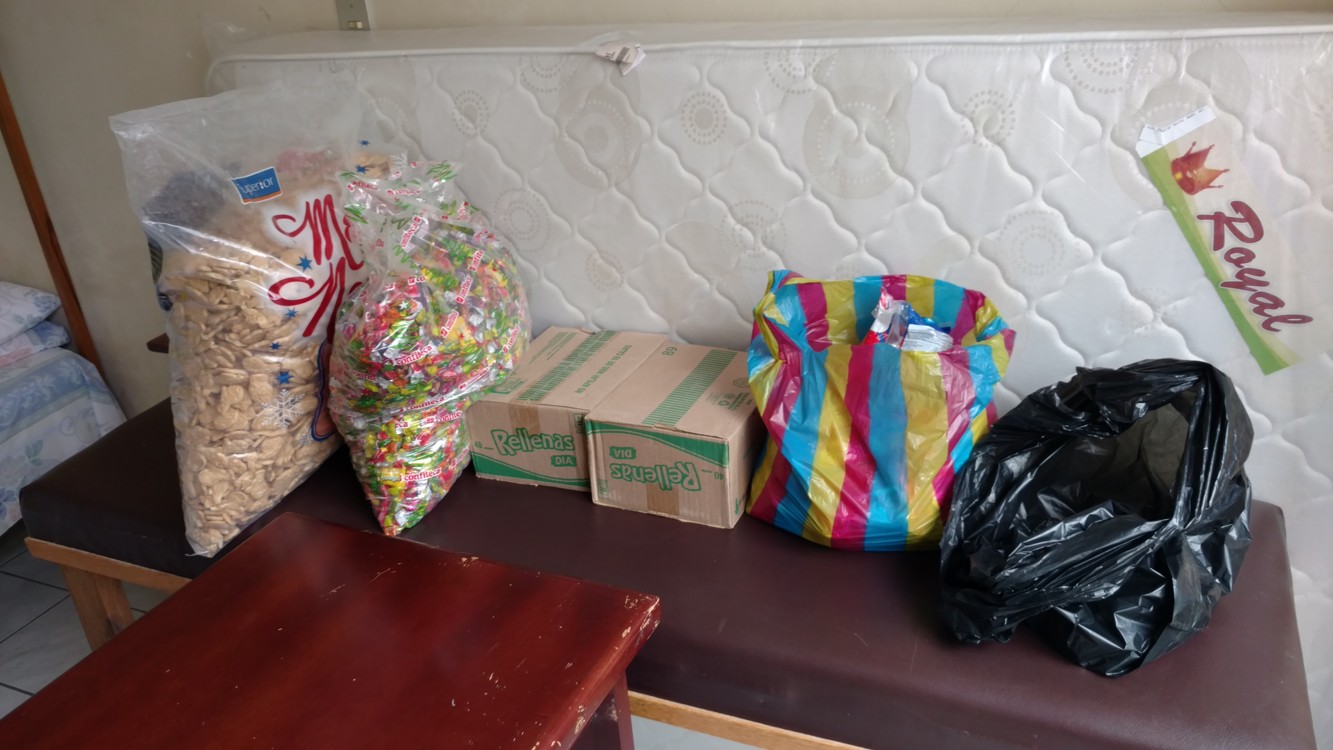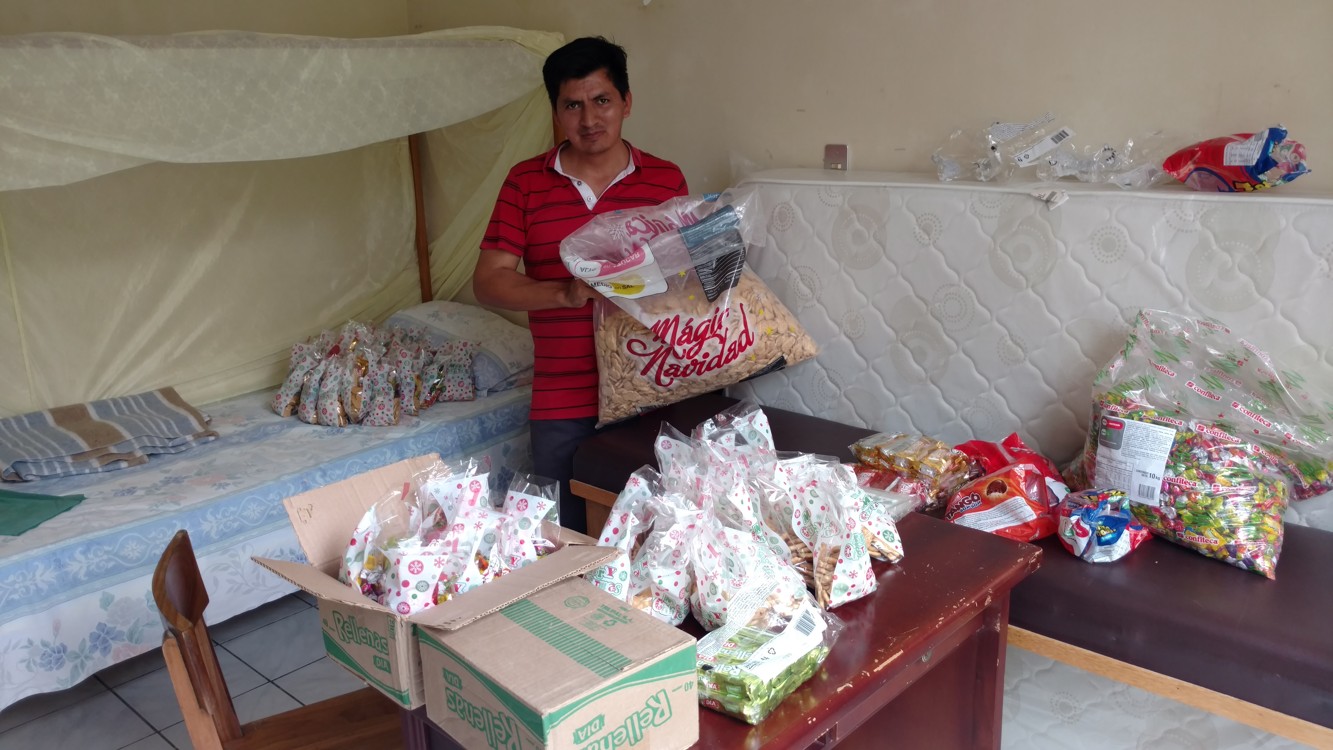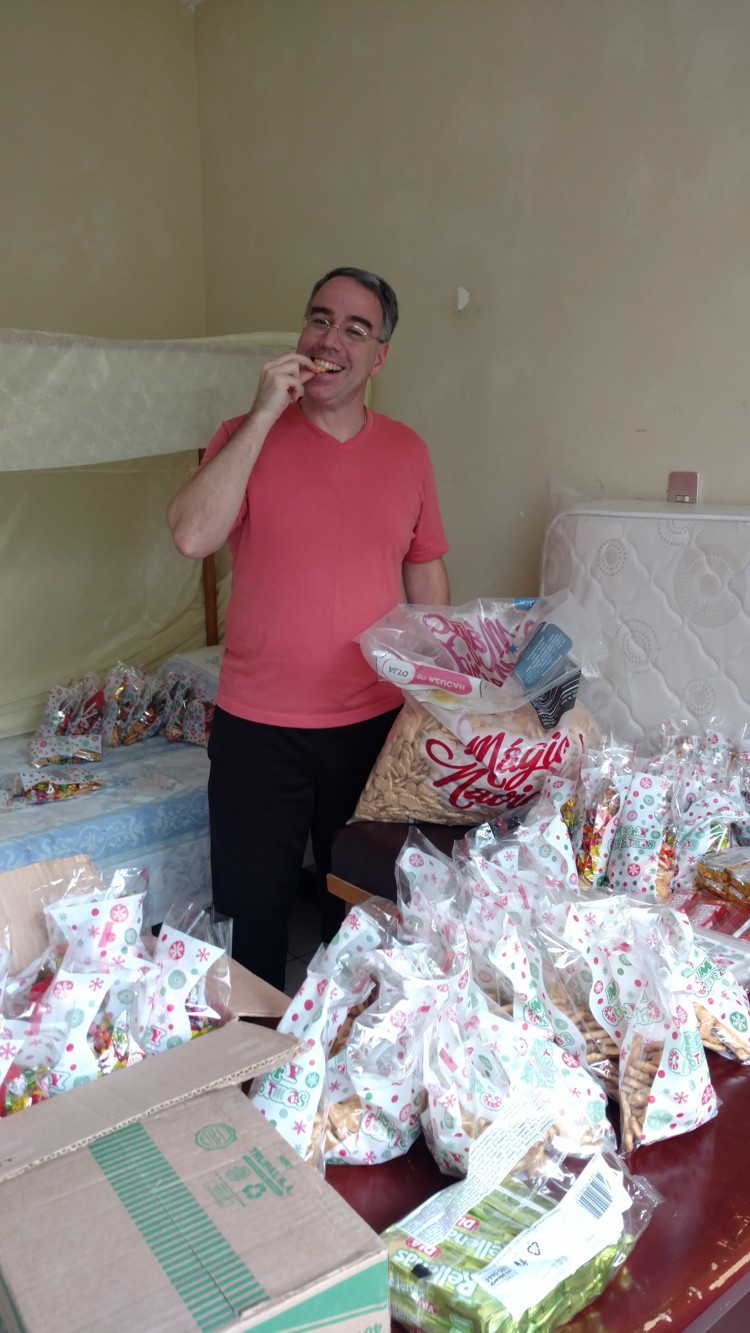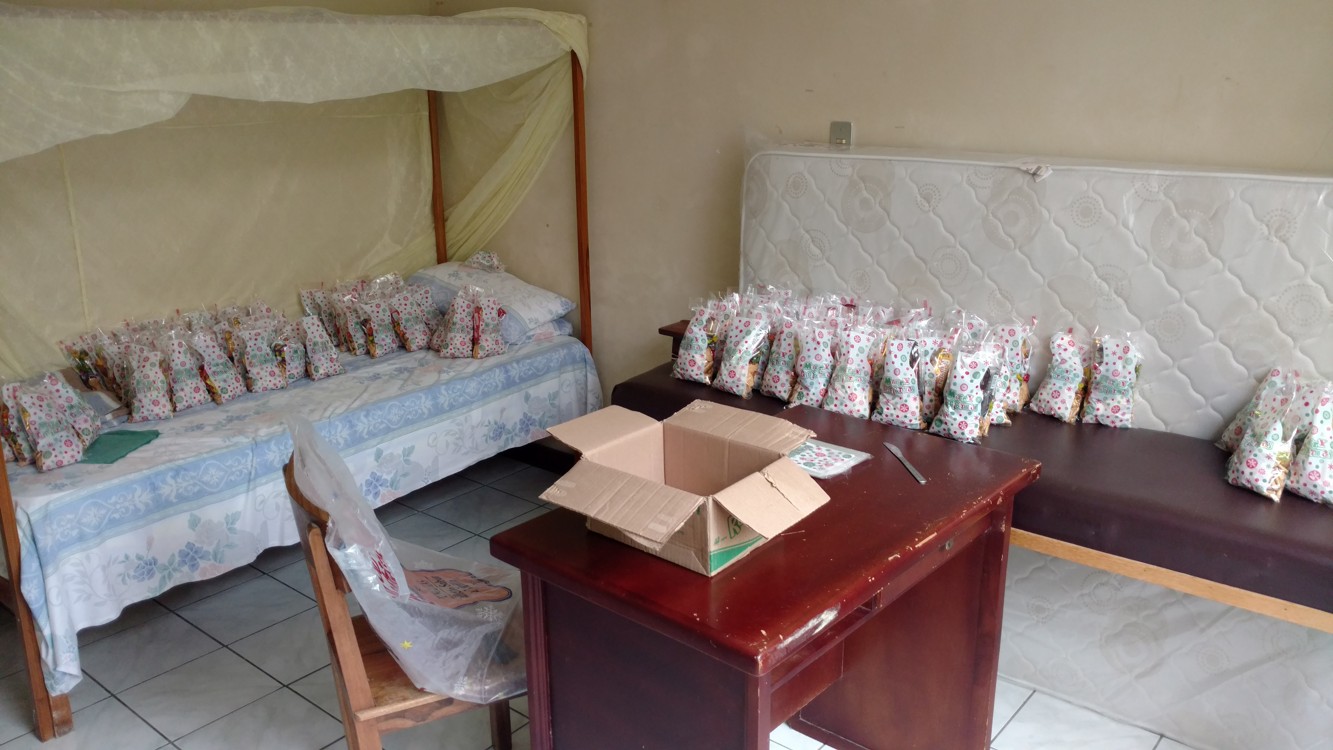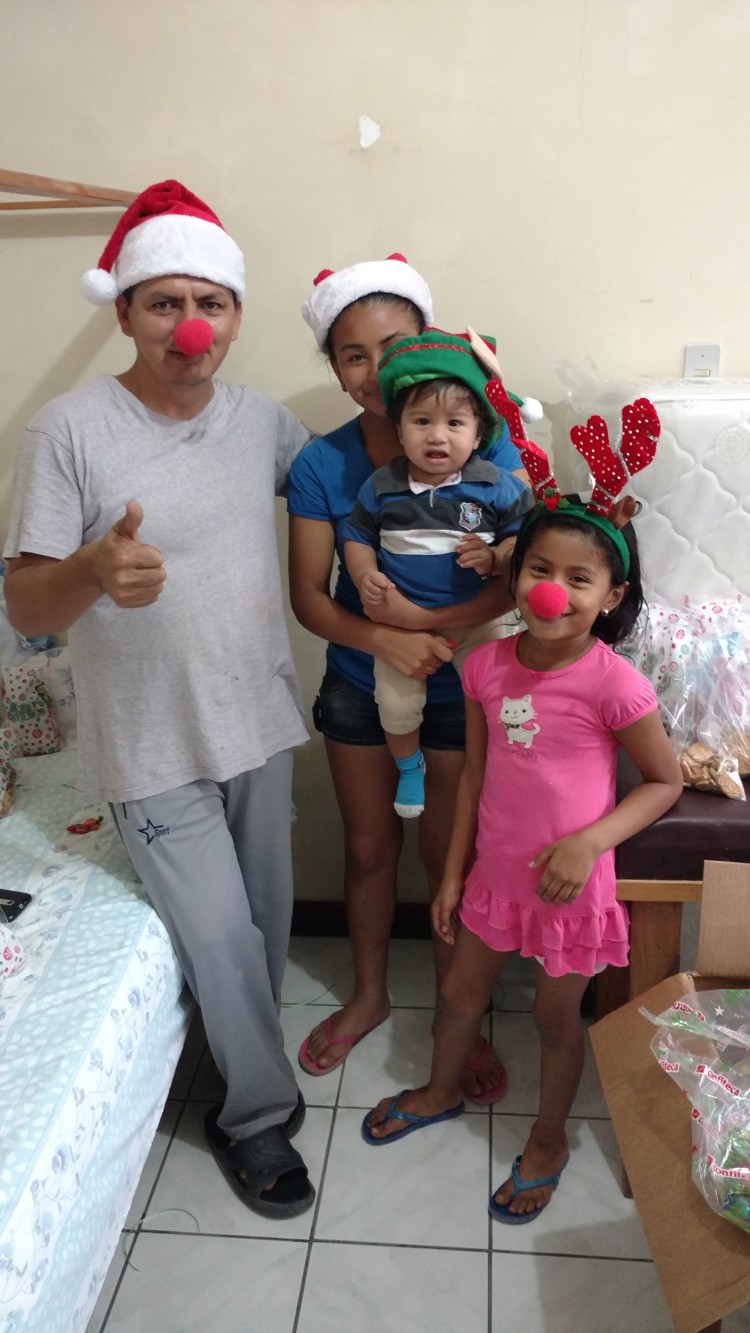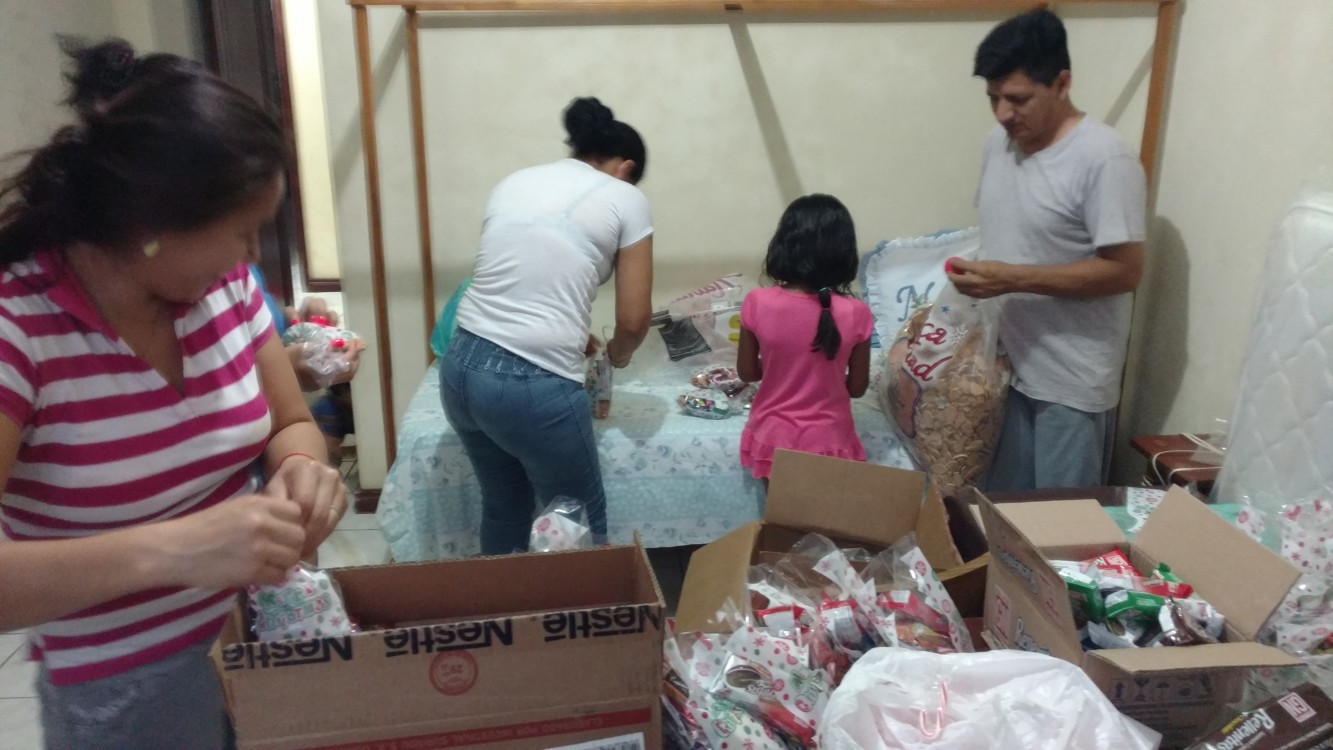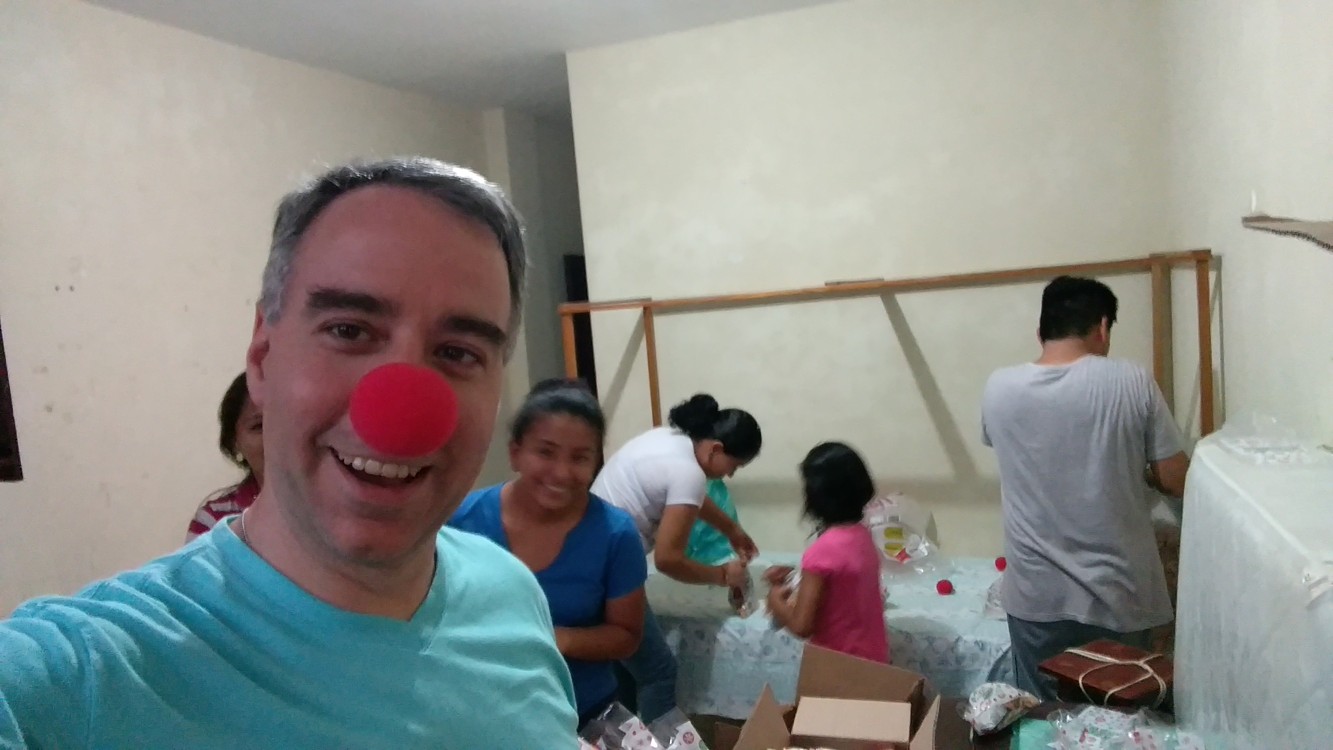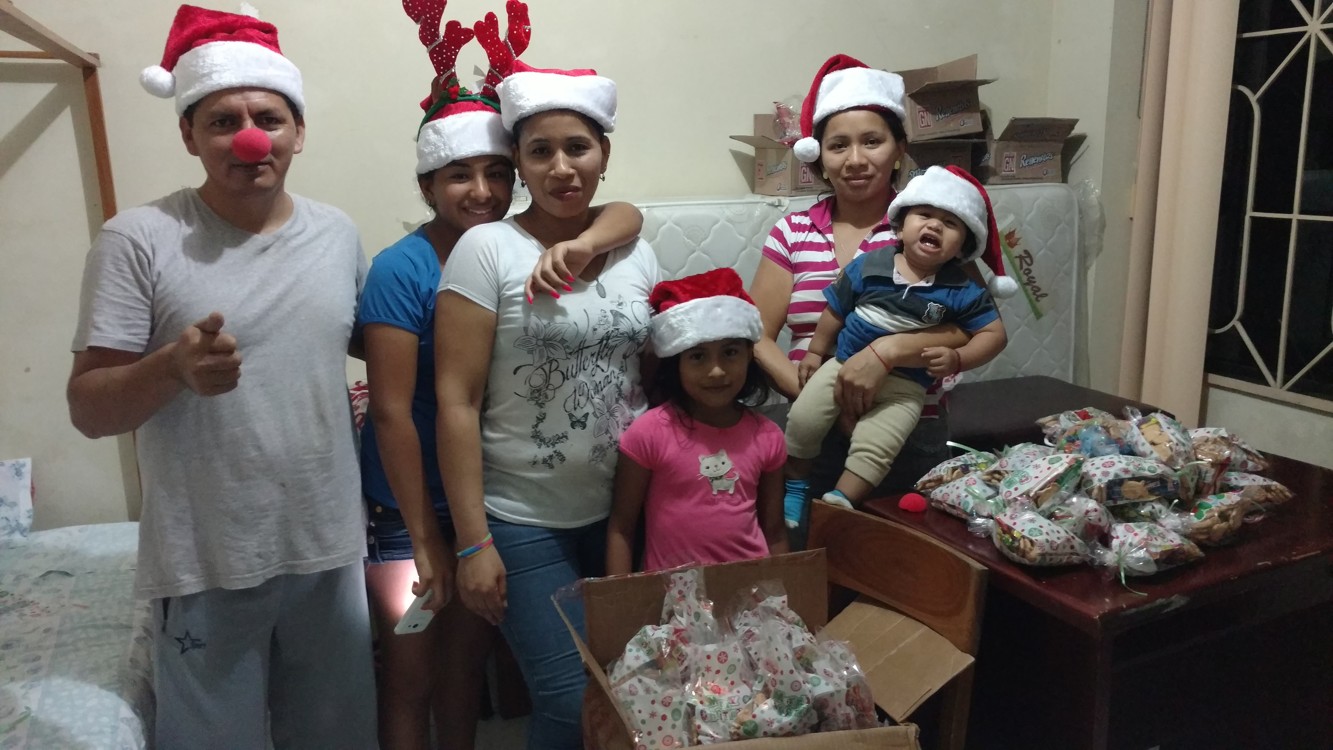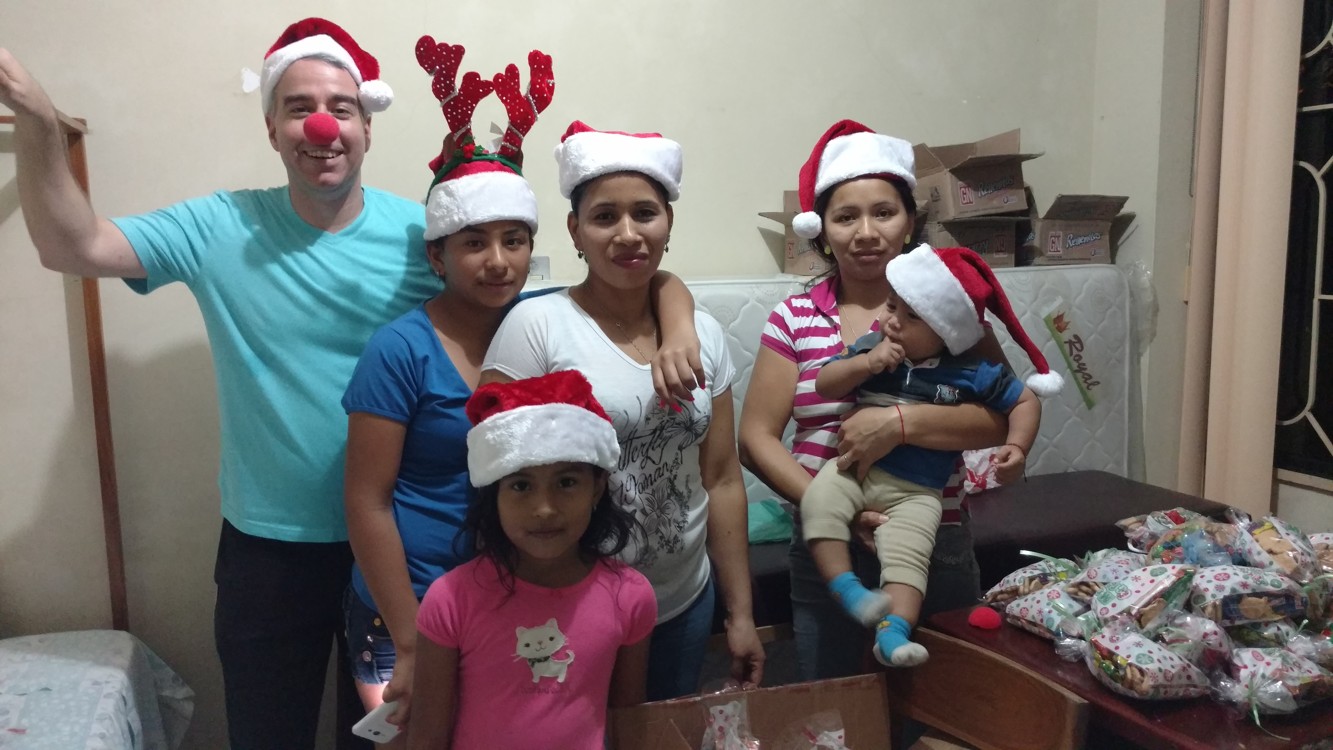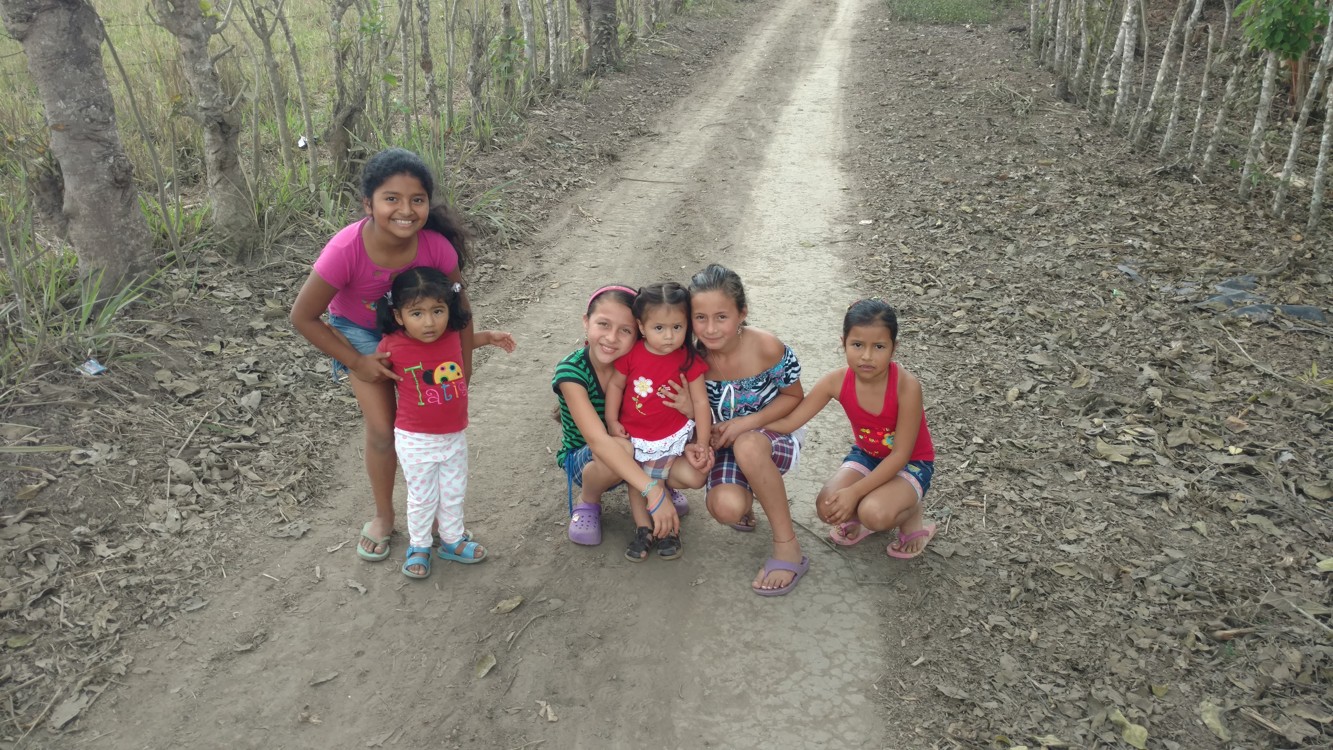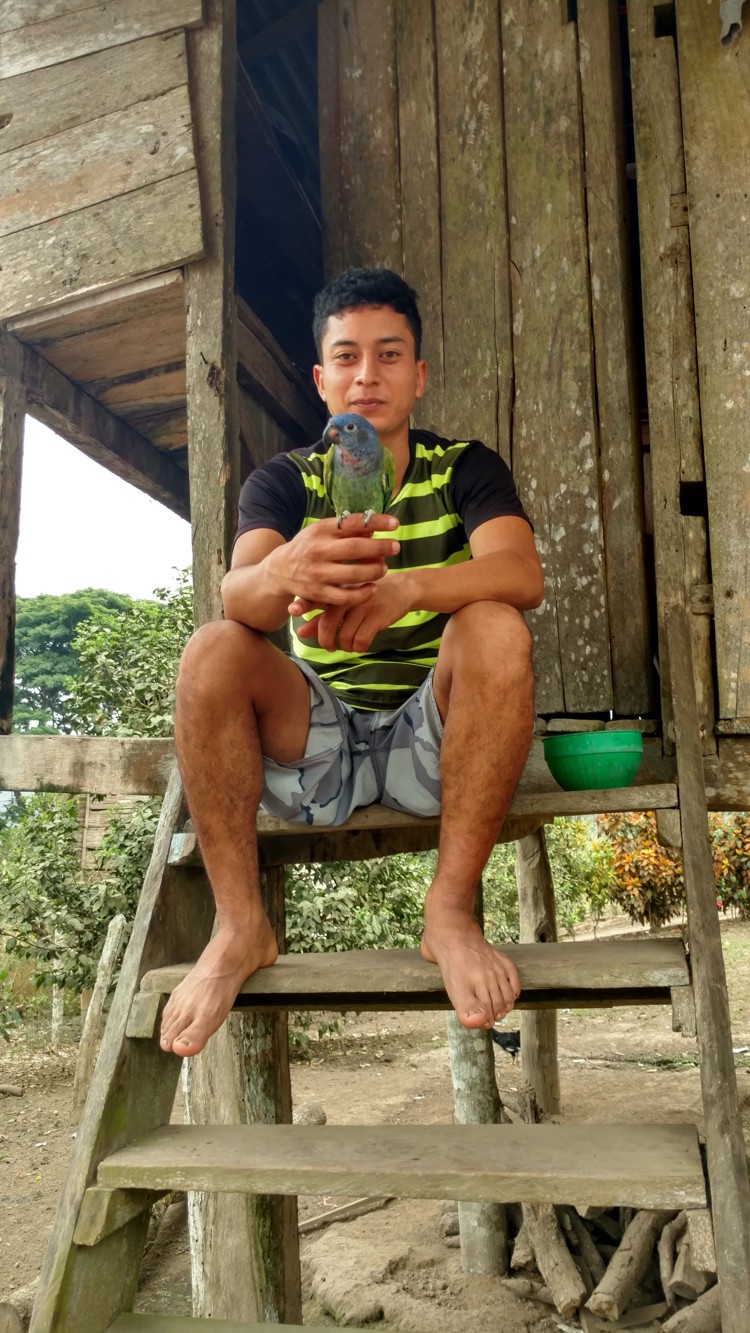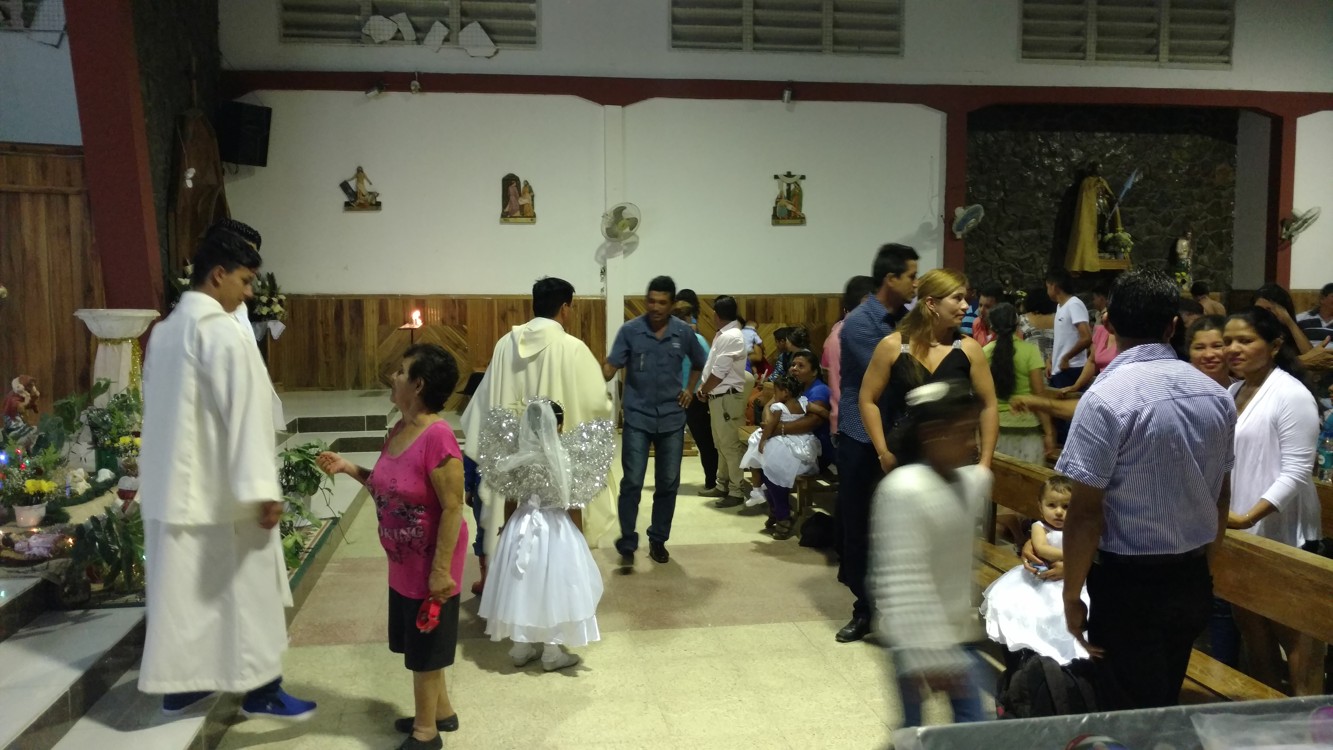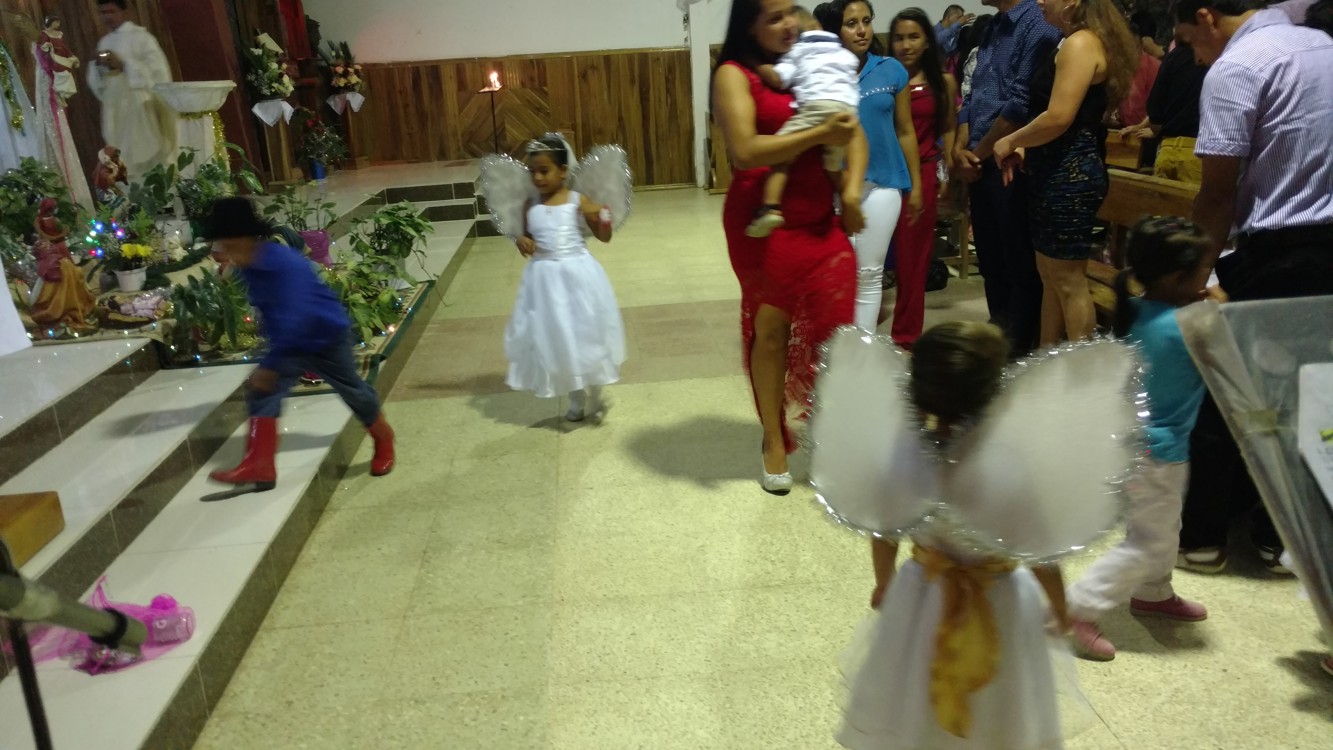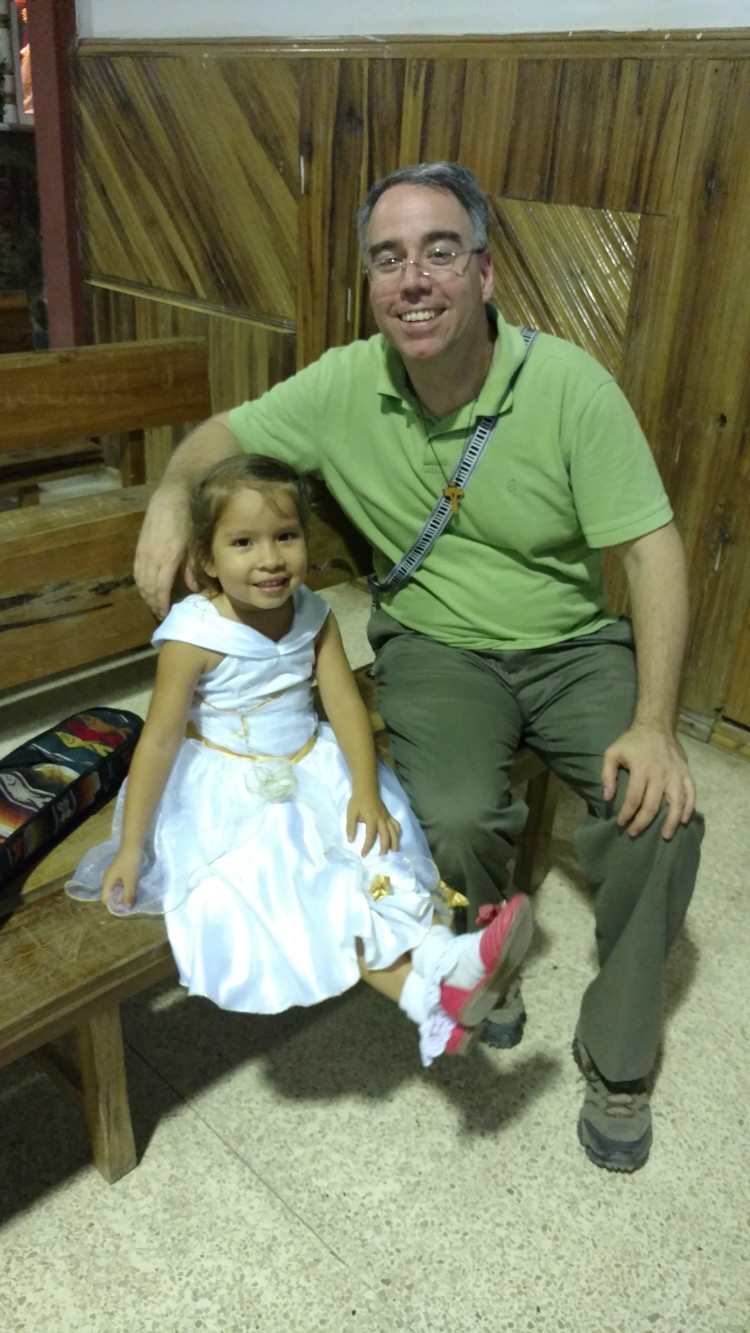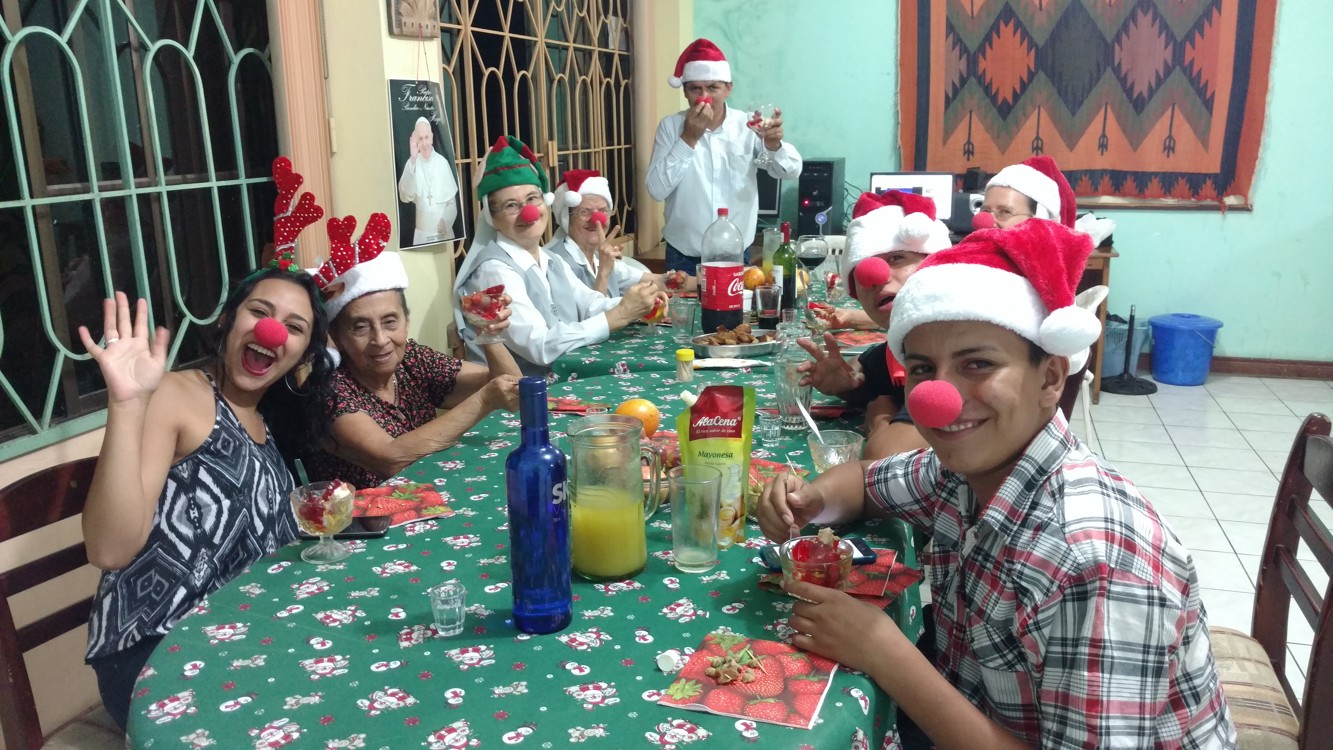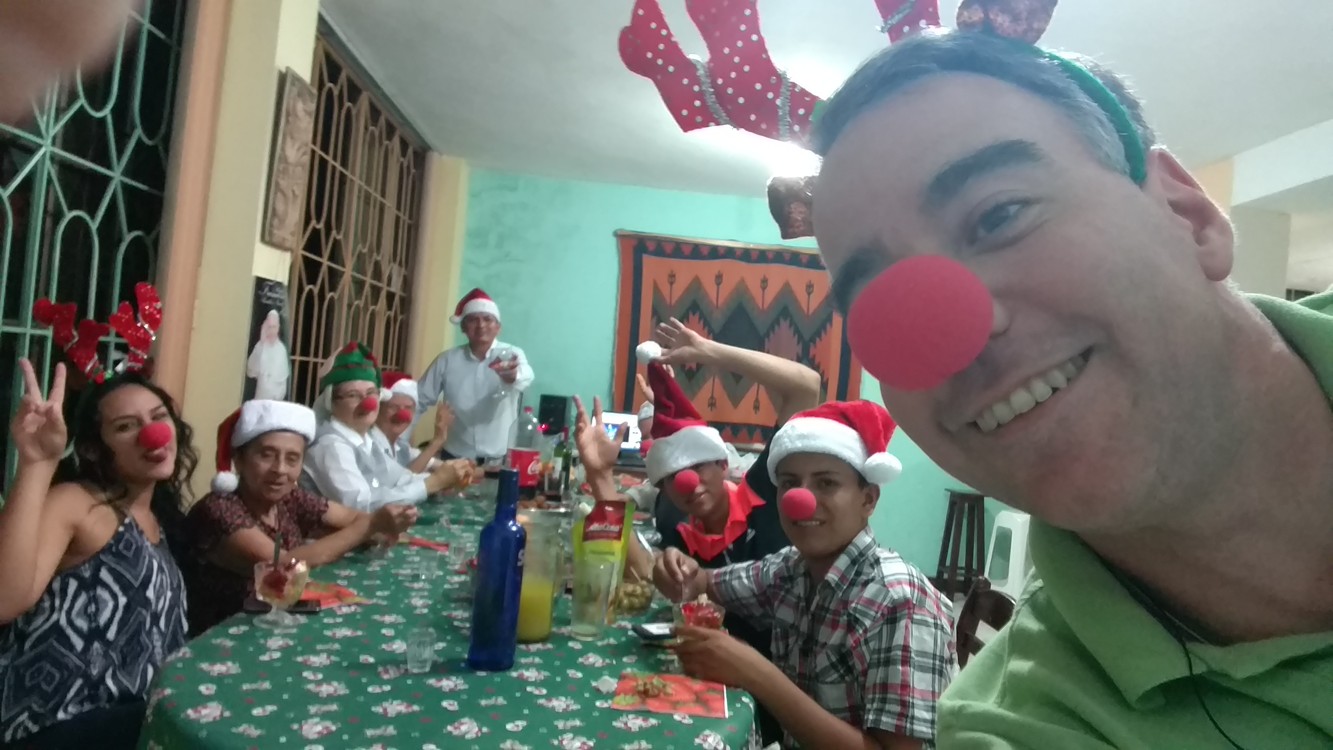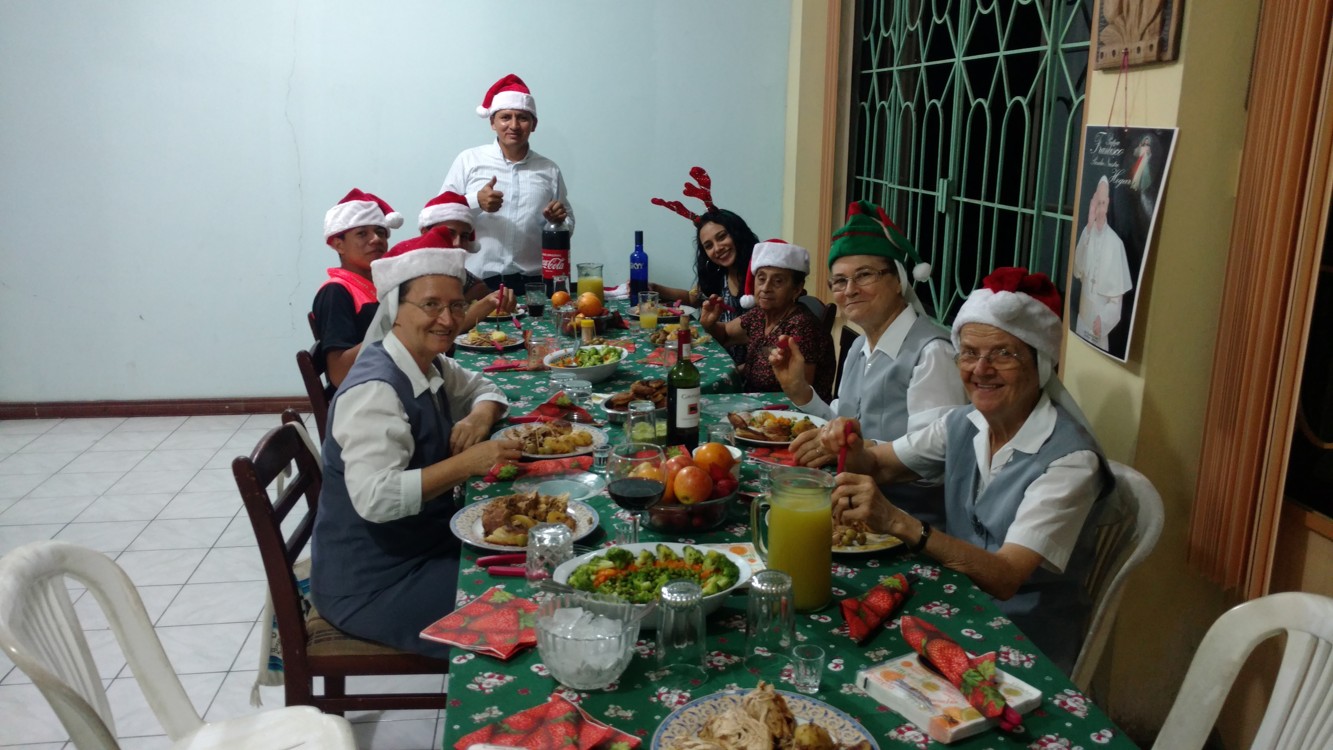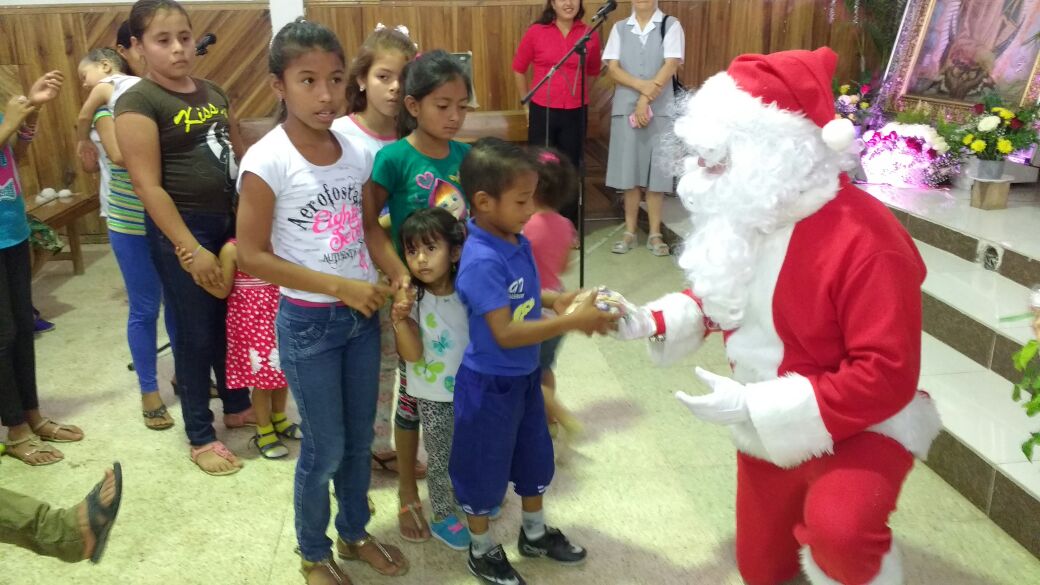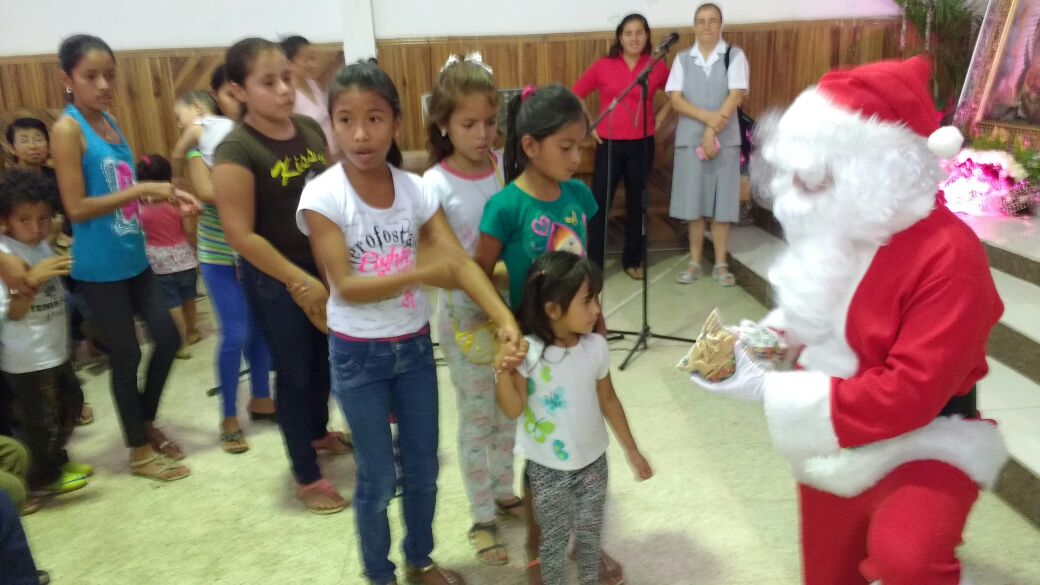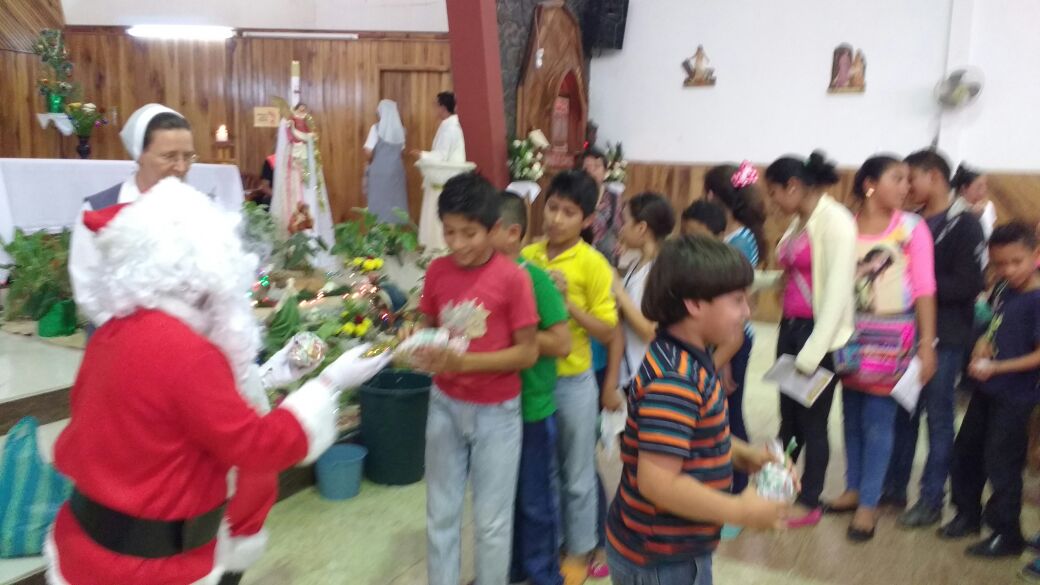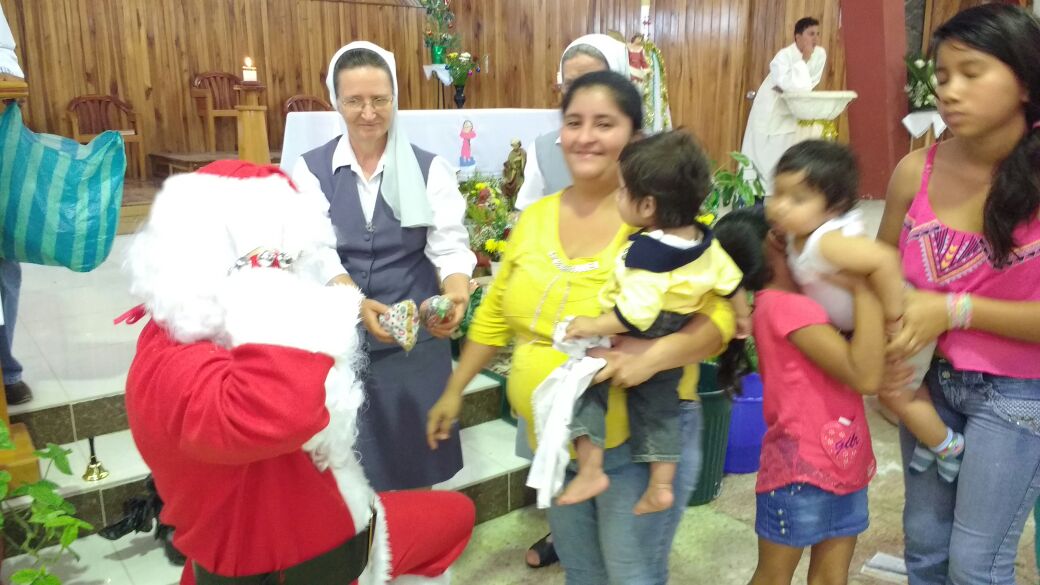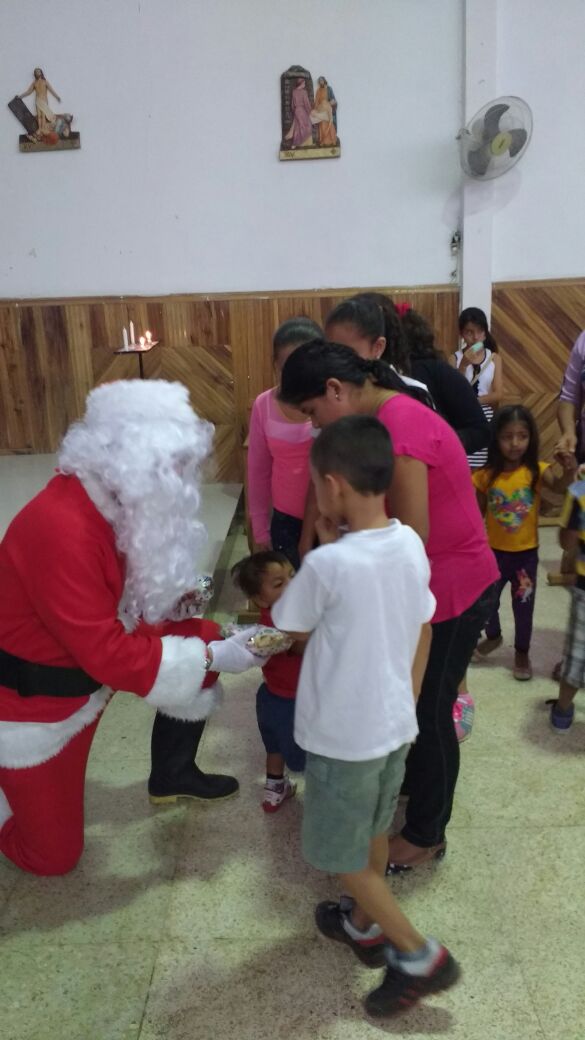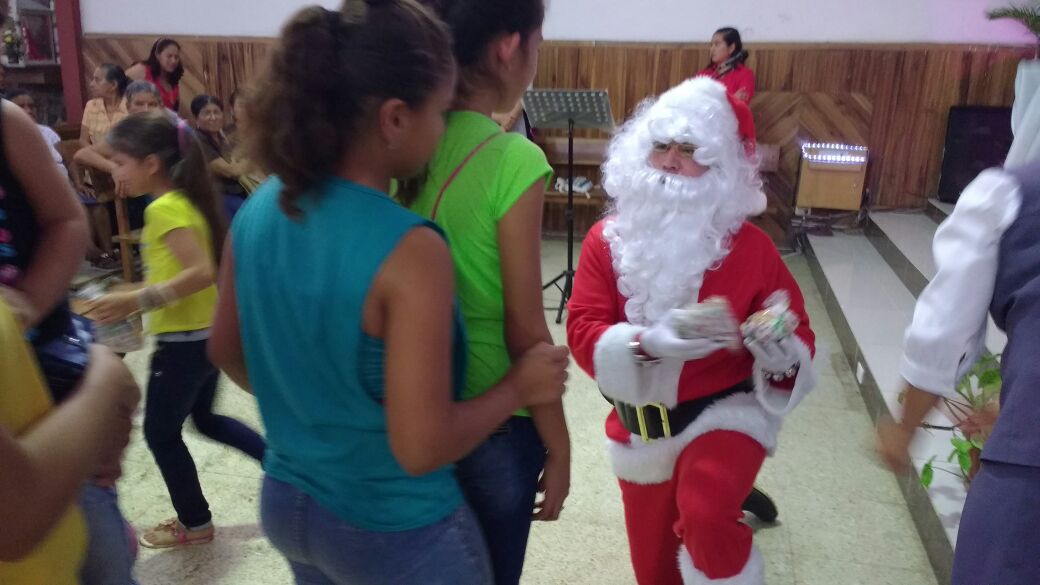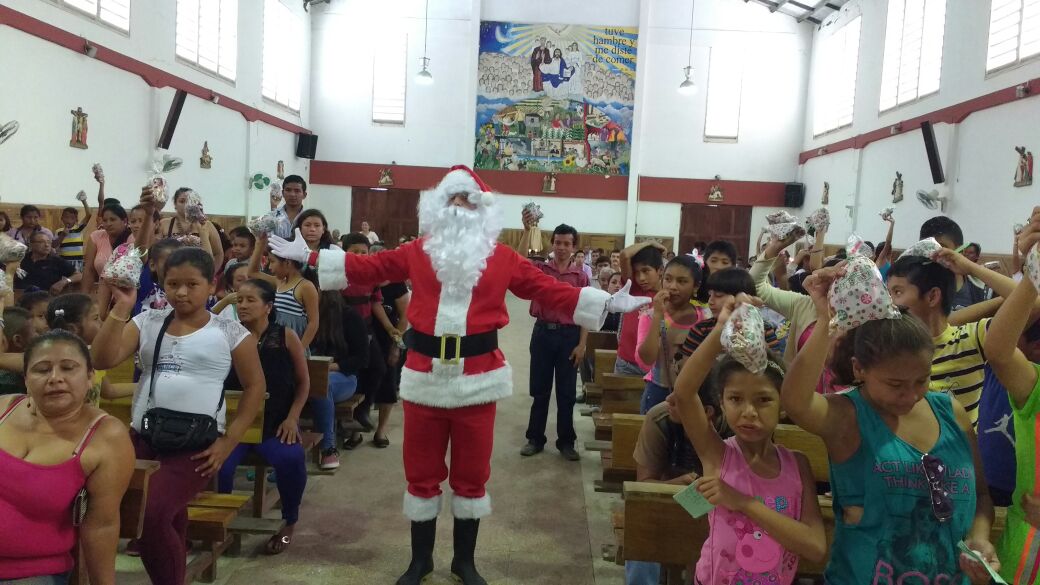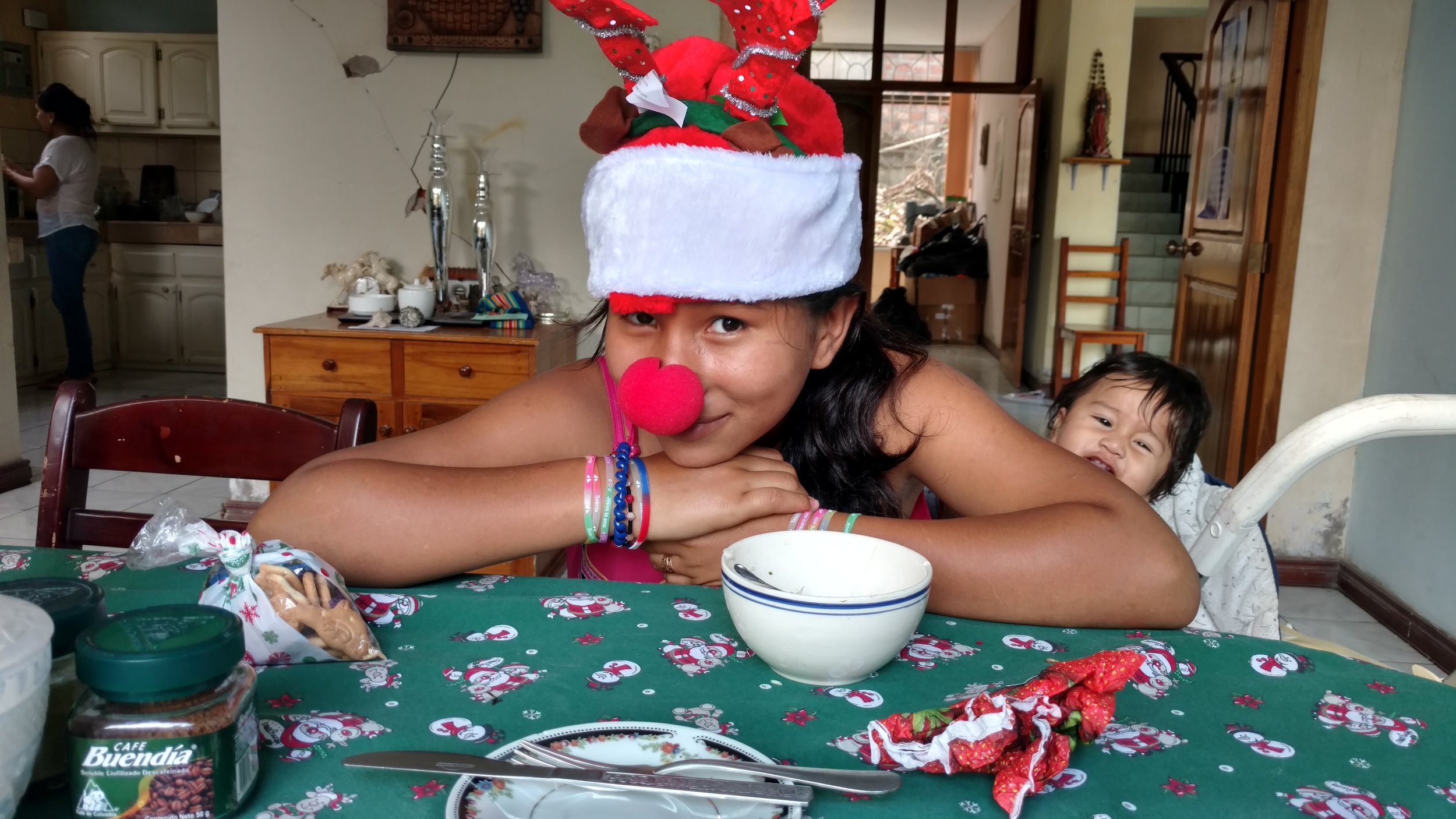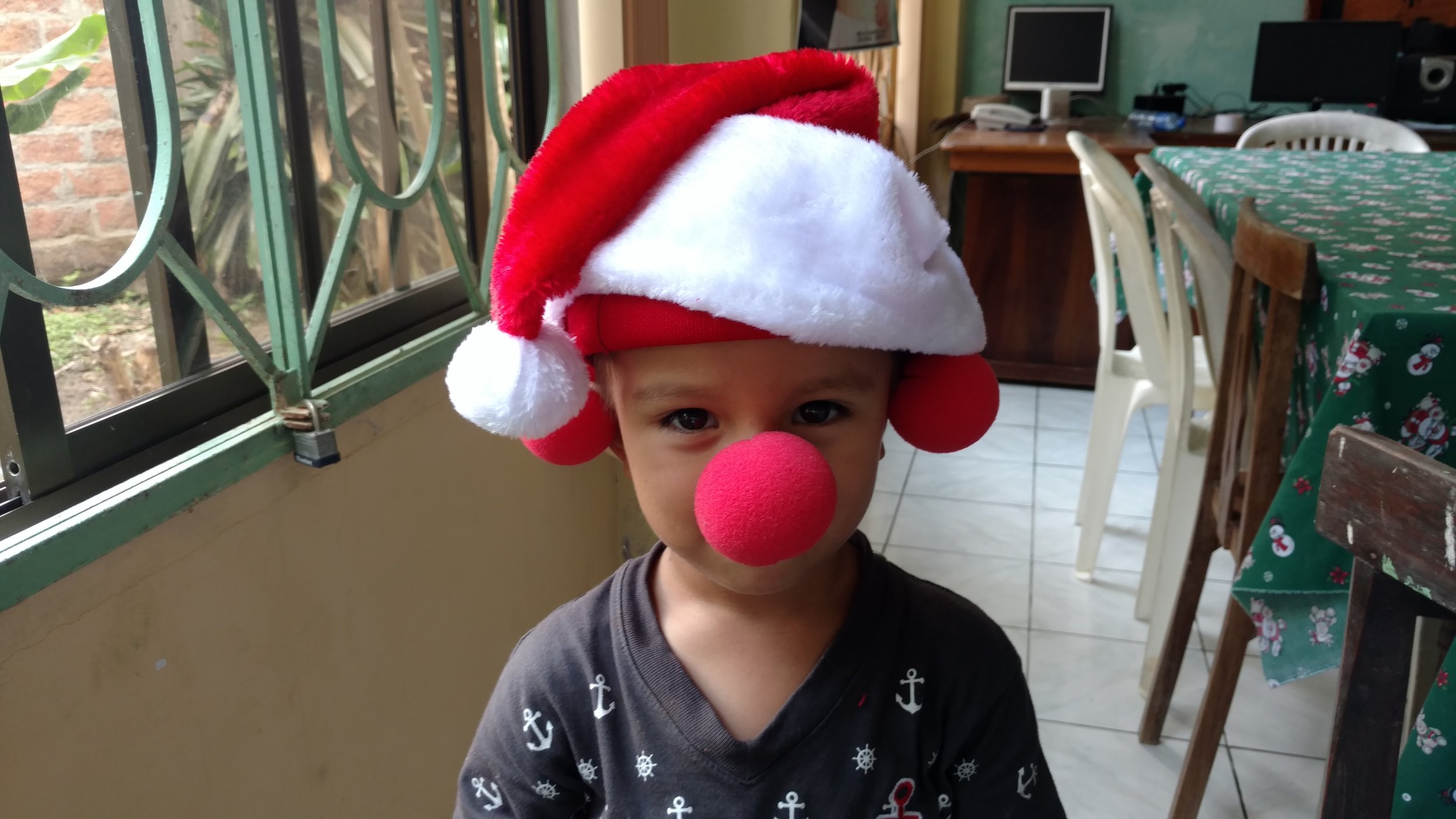I hope you've had a great Christmas!
I moved into the parish house where the priest stays on December 14, and I have spent a lot of time traveling with him visiting villages and getting to know the area. There's a lot to share, so here goes:
Christmas Novena
One of the things I came for was to be a part of the Christmas novena, which is held for nine days before Christmas throughout everywhere in Ecuador - and I believe in all of Latin America. There was a novena in the main pueblo, held in the main church. I felt it was a bit lame, because there were 3 nuns plus me participating in these novena services, which is typically a sort of "waste" of personnel, to draw an analogy. I would be more accumstomed to dividing up in pairs and visiting villages to accompany the poorer people in the "campo", the country, in a sort of novena "mission". This is quite common in Ecuador, especially in locations such as this, where there is a hub "pueblo" and a number of surrounding country villages with their own little chapels and worship spaces. But, we were all in the center, which was disappointing to me.
As you might guess, that sort of inefficiency doesn't produce a good "product". The novena celebrations were poor, as we used an accompanying booklet, and the sisters went by the book. It was very much out-of-context and awkward, and yet the people accept that. A booklet can only be a guide, as every place is different, and the people directing the service need to put together a service that utilizes the booklet as much as it is useful, but is not bound to the booklet. That didn't happen, at least until I had the chance to give a reflection, and instead of reading the one out of the booklet, I shared something that I thought might be relevant and relateable. But there was very little participation of the people until the singing of songs at the end, unfortunately.
That is a recurrent problem in Ecuador and I suspect much of Latin America - a scattering of things out of context. You see this all the way from fiestas to church liturgies, to social institutions, businesses, basically everywhere. You see things are placed with other things that have nothing to do with each other. For example, I have seen a picture of Jesus placed next to a picture of the Tazmanian Devil cartoon character. It is a fragmented way of living, and it leavens the culture. That is why I like to take that scatteredness and bring an underlying unity and fabric to things in what I do. But if the leaders of the church can't/don't do this, it makes everything all the more difficult.
In any case, it didn't seem to me that anyone left the novena each night inspired. Usually, in other places, the crowd would leave the church in procession to someone's nearby house - a different one each night - and there have the novena. After the novena, the doll of the child Jesus would then pass the night in their Creche scene, and they would bring it to the church for the next night and someone else's turn. It can become a symbolic aid to help enter into the Christmas mystery. But that didn't happen - it seemed the people came more out of heavy obligations and remembering some traditions. One of the traditions here in the province of Manabi is the singing of Chigualos, which are witty two-liners between an initiator and the rest of the people related to the nativity. Someone sings the first line and everyone repeats. Then the same person sings the second line and everyone repeats that one. It's like a freelance rap session, and the people really enjoy it. Some of the lines are simply devotional, some are funny, and some are quite clever. The whole activity begins with the same chigualo: O green bird, with color of lime, the child of my heart is coming. And the whole session ends with the same chigualo: I'm standing here in the doorway, and with this verse I say, "Good night!" and everyone waves goodbye as the night has come to an end!
Caramelos
Caramelos, or navidades, are small bags filled with sweets. They typically include animal crackers, a lollipop, a chocolate, and hard candies. You can buy the caramelos already bagged and made, but it's a bit cheaper to buy the ingredients separately and make them yourself, although it's time consuming. That's what Pd Oscar and I did for the Secret Santa meeting of the religious ed instructors. We spent about 3 hours in total filling about 100 bags!
I later went out and bought a Secret Santa gift so I could go to the meeting with the religious ed instructors, there are about 80 or so I think. Anyway, I got a soccer shirt, but gave it to one of the girls of the house staff because it was too small. I already have two anyway! But it was good to spend a bit of time with those who are involved in the catechesis in the parish.
Later, I bought ingredients to make another 150 bags for the kids that would come to the Sunday morning Mass on Christmas morning, when I would come in as Santa. We bought everything for about $150 or so, and with the help of Diana and her kids and nieces and other staff who work in the parish house, we were able to put together the caramelos for all the kids and have some fun in the meantime with some Christmas attire I had brought.
Visits to Communities
I asked Pd Oscar if I could go and visit a community during the week and he arranged that I go to Muchique 3, which is about a twenty-minute ride on dirtbike. I arrived and as able to meet with about 11 or 12 of the children in the village for about an hour and a half - we had a lot of fun. We did several dynamic games that the kids loved, and then we slowed down to a game I put up on the wall with my little projector. Then we settled into a cartoon movie/video about the nativity story. Finally we did a little question and answer lesson on the video. And then we finished with a few more games and a final dynamic to wrap up. We all enjoyed it, even the parents! From there, I visited two homes as time was tight. The religious ed teacher showed me around and we visited Rosa, an elderly widow, and her daughter Johana, who is paraplegic. To witness their way of life and how they live, it is incredibly humbling. You get the feeling of meeting Jesus in the cave at Bethlehem, that you are with people who are blessed, although they may not recognize it. We prayed briefly and had brief conversation, and then visited another house, where a young woman who has a disabled leg lives and briefly prayed with her. I hope to be able to come back on another day at some point. The hope is to first convey how blessed the people are, and to support them in their lives. And in all of it, I receive the incredible gift of their friendship and the sharing in their life and blessedness. At the end, I got another ride back on a dirtbike back to the pueblo … I wish I had gotten a picture of all of us together, but I got a few of us on our way to the schoolhouse where we gathered:
On the eve of Dec 23, I went with one of the sisters on a half-hour drive to the village of Dominguillo for their Christmas Eve service at 9pm, which is what they would have instead of a Mass. I was able eventually to use the charango for some of the Christmas songs, and to share a reflection with the community. The idea was that John the Baptist goes before Jesus to prepare the way, because Jesus is a king. But Jesus doesn't need a red carpet, he doesn't need a throne, or even a nice place to sleep and be born. He doesn't need a nice meal, or security, a nice house. He doesn't need a nice ceremony, a nice church building, great music. John the Baptist shows us that Jesus only needs one thing to prepare the way for him to come to us, and it's very simple: If you have more than you need, share it with others who don't have what they need. It's that simple! ... Afterwards, as usual, we were invited to eat in a house
A quick picture in Dominguillo with one of the religious ed teachers - it's a bit rude to walk into someone's place and start taking photos when you don't know them yet, but this one worked!
Christmas Eve
Beginning in the afternoon on Christmas Eve, I accompanied Pd Oscar to three communities for Mass or prayer services, accompanying with leading the music. The first community was mostly a group of 6 families who were having their children baptized in the local chapel, which has fallen to pieces with the earthquake. So, it was basically a baptismal service, though I got to meet and speak with some members of the community.
One of the girls baptized.
On the way to the second community, we stopped in someone's house for a quick coffee. The lady of the house also gave me a sample of the coffee "essence" which they grow on their farm. It was nice to experience and taste fresh organic coffee - it's very bitter!
The "essence" of natural, home-grown coffee
The second location, Palmar, also had a chapel that had fallen to pieces. After the Mass, I spoke with the community president and the religious ed leader about coming back to do something with the children. They also are hoping for some help with the chapel. This community has especially suffered, especially at Christmas time. Six years ago on Christmas Eve, a full bus coming from a nearby city went off the edge of a cliff, losing all the passengers, 15 of which were from this community. Christmas has never been the same for the people of Palmar, and for the whole of San Isidro. At the time of the event in 2010, the whole pueblo center was filled for an outdoor Mass for 20 people who had died in the accident. The bishop had come to visit and specifically visit Palmar, to share in their grief and offer hope. So Christmas has now taken on a different meaning for many people here… I hope to be able to make it to Palmar again before I leave after the new year.
The third location was a small house in another village - we had to get out of the truck and climb a small hill to reach it. This family had also lost a daughter in that same accident, Maria Auxiliadora, and her family has a Mass or prayer service each year on Christmas Eve in their home. It is a poor, simple home, and the family is very simple: a mom and dad and two surviving daughters. They had a picture of their daughter mounted on a small altar in their sala, and there we had the ceremony. And as usual, they gave us a meal. It is always hugely humbling to me to enter into the lives of people like that. It is really one of the most sacred spaces in all the world, the poor simple house of a family grieving the death of a loved one. It really is an encounter with Jesus. I make sure to speak with everyone at least a little bit, it feels like special moment of grace…
I recall telling Pd Oscar afterwards how I learned a long time ago - how God had prepared me - how to enter someone's sacred space like that. When I first had this experience with God, I immediately started to do two things: proclaim the scriptures and visit the sick, bring Jesus to the sick in the hospital. I remember that it was there, going about and visiting strangers' hospital rooms, that l had learned how to enter another person's sacred space…
After that, we returned to the pueblo for the Christmas Eve Mass, which was packed and where a few kids had dressed up as angels. It was a bit disappointing, in that typically there is much more activity for the "Nochebuena" or Christmas Eve Mass, as it's the real center of Christmas, not the actual 25th. In other areas, there have been processions and organizations of the Pase del Niño, where people would dress as Christmas characters and there'd be a whole dramatization and procession through the center of the pueblo. Maybe a lot has been lost since the deaths on Christmas Eve 6 years ago …
I had been trying to accompany in the church with the music, as there is a young guy who plays the guitar, which is hooked up electrically. My charango is not, so it's basically in the background. But that's a good thing, because the guitar player doesn't sing, and that leaves it to the nuns to sing. They don't coordinate well with the guitar player, so it always comes out in mixed keys and I don't know if I should accompany the guitar or the nuns' singing! It brings up, though, something important about Latin American culture which is a problem along the lines of what I mentioned previously, and is a problem if people like missionaries support it: that is, settling for fragmentation. When the guitar player and the singer, who are leading the crowd, are always in different keys, it means that it's time to do some of the coordination work to defragment the situation. Even if that means not playing the guitar, or not singing, or whatever. To go forward week after week and not address that your lead music is completely out of harmony, is to miss a major point about human life, especially Christian life: reconciliation!
After the Mass, we all got together for a big Christmas turkey meal in the parish house. Pd Oscar, the three sisters, plus two of the altar boys, the sacristan woman who sets up the church for events and her granddaughter. The meal had been prepared by the house cook Diana, but she couldn't stay for the meal. House cooks do a lot of work here, and I think they deserve more! Anyway, it was a fun dinner as the pictures tell, and the first time I had wine in a while, which was a nice surprise for me.
Santa on Christmas Morning
On Sunday morning, I came down to the church after the 9:30 Mass dressed as Santa, or Papá Noel. This Mass has a lot of the poorer kids from the campo in it, because, coming from a longer distance, they can't make either the Saturday or Sunday night Masses. It also has the kids from the earthquake refuge shelter (there are still a number of families without permanent residences from the earthquake), as they can't make the night Masses for security reasons leaving the refuge shelter.
At the end of the Mass I came into the church and was introduced by the priest, gave a big "Feliz Navidad!" and Hohoho laugh, and everyone applauded and laughed. I then got the microphone and gave a little talk about how God gives us Jesus as the gift of all gifts, and it's because of that that I go around giving out gifts. Then I mentioned how everyone in the North Pole knows what happens in San Isidro, the joys and the sorrows, and that we know that it's been a tough year. So, I asked the elves to go around and gather some of the tears from the year, and we'll ask God if He'll turn the tears into snow from the North Pole. I said, for that, I need the faith of the kids. Do you believe that God can turn the waters from the tears into snow from the North Pole? Yes. I need more faith, do you believe???!! YES!!! I then laughed and said, "I do, too." So, we had a big bucket of water next to an empty bucket that had the powdered snow in it, and I began to pour the water from one bucket to the other. I made the mistake after the initial pour to pour the entire bucket of water all at once. For the powder to really take in the water correctly, it needs it bit by bit (I've now learned) - so it was coming out as slush, no matter how hard I tried to mix it. By now, ALL OF THE CHILDREN IN THE CHURCH had come to surround me and the bucket on all sides (did I mention that the idea of experiencing snow has a delirious effect on Ecuadorian children - and adults). The pressure was on … what was going to happen? I had asked God to turn the water into snow, and we had all expressed our faith - and now it was slush. I kep mixing to see if something would change. Pd Oscar said, should I get some more powder, but by then I didn't know where I had left the extra - probably back in my room. And then an idea came to me…
I paused and said something along the lines of: wow, you guys are really special, because this wet snow is the most special snow there is, you can only find it in the center of the North Pole - I wanted the regular snow, but you've got even better - wet snow!
By then kids were reaching in and grabbing some, and that extended to everyone including the priest and there was some throwing of wet snow. Some kids were making snowballs to take with them. Slush covered the ground, and I breathed a little relief as the kids had a good experience.
Then, we brought out the caramelos, and the sisters helped me to give one to each of the kids, one by one. It was a great experience, and the kids loved it. Afterwards, there was time for pictures, and the kids were glowing.
There were plenty of funny moments, but I'll share two. Some of the kids from Monchique were there, where I had been earlier in the week. One recognized me and asked me when I would return to Monchique. I did what any upstanding Santa Claus would do, and the only thing a person can do in that situation: I winked at him…. When another boy whose name I remembered came up for his turn, I said, "Merry Christmas, Alex", and he froze with eyes wide open. I don't know if he was surprised that Santa knew his name, or if he was recognizing who I was! I think it could be both …
It makes me reflect on something. Back a few years ago, I was invited into the school in Chontal to share some English with all the kids from grades 7 through 9. It was one of my first times visiting the school and staying longer than a couple of days in Chontal. I didn't have a lot of good ways to get to know the people, especially the kids, especially with my language limitations. So, in teaching English, I had the opportunity to teach greetings. And what I did in every class was go around, get on one knee, and look each student in the eye with a smile, shake hands, and greet them and introduce myself, and let them respond was well. I am sure that there is no other person in the world who has looked into the eyes of each one of the those kids with a smile and shook their hand. There is a reason that I am well received there by all the kids. It's the same thing here. I am very sure that there is no one who has been on one knee before each and every of those children, smiling into their eyes with a greeting of love …
Later on, I got to spend some time playing around with the kids/nieces of Diana, the house cook. Having fun being goofy with the kids ...
Later on Christmas Day, there was a funeral for a 17-year-old young man who died in a bus accident two days earlier. Because Pd Oscar had already left for his vacation, Sr. Beatriz and I had a funeral service instead of a Mass. The church was completely filled, and it was a hugely emotional time, with many people sobbing, and the mother screaming and crying until the beginning of the service. In Ecuador, there is no practice of using embalming fluid - in most cases there is no access to a funeral home or people experienced in that type of thing. So, a burial really has to happen within two days. That leaves families with no time to grieve, especially if the death is sudden and unexpected, like this one. I have seen cases where a man is alive one morning, and the next afternoon he is buried. It is a trauma to the family, and the first times I witnessed that suffering of the family, especially at the gravesite where the body is placed in enterrment in front of the family only a day or two after everything had been normal, the wailing and suffering I heard I will never forget. It made me cry, and everytime I see one of these deaths, it makes me cry because it is another blow by poverty to their lives.
I was to give the reflection at this funeral, which is a humbling thing to do. I decided to focus on the theme of the caterpillar that turns into a butterfly and is still present, although it's not recognized anymore. And I shared two important things that help to recognize the new type of presence of our loved ones: the value of the water of our tears and the need to cry and grieve and express everything inside, and the need to honor the memories we have, to share them and treasure them. This is the way the people of God have always come to know the resurrection, through water and memory, and it's a process for everyone… There is not much more to say, except be willing to accompany people… There is a great problem here in my experience in Ecuador, that people never tell stories of their memories of a person. They don't know how to honor the memory of a person with the stories. I've never seen a funeral where anyone has ever shared a story of the life of the deceased. Never! On the contrary, there is a constant pressure to "just move on". That is the constant theme: don't cry, just move on. It's what the church leaders often teach, sadly. There is such an oppression in the culture, that their need to healthily grieve is stifled, especially by the church. I say all that because someone got up to share words at the end, and there was nothing about the life of the young man in his words, what he was like, a story maybe, things like that. Nothing. It is so sad.
At the end of the service, about half of the people in attendance crowded around the casket crying and sobbing, and then the casket was taken out to go to the cemetary. I thought, at least no one is holding back on the crying, which is a good thing. I hope some day they can come to speak about the special memories they have shared with a young man who died young.
Recovery and More Earthquaking in San Isidro
Much still needs to be done in San Isidro, as the reconstruction of homes is slow. People have their daily needs satisfied, and are living in homes in a provisional way, but there hasn't been too much progress. Hopefully, some good can come out of my observations and lead to something down the road.
The chapels in the communities remain largely broken down. It's possible that money will come from St. Mary of the Assumption in Lawrence, MA, but that isn't confirmed yet. If the money that has been talked about does arrive, it would take care of the principal costs of all of the chapels in the parish, according to Pd Oscar.
What is common to see here is that many homes have been deemed unsafe, like this one in the picture. Others have the note "conditional use" on them. So, people are still struggling to have a safe home to live in.
On December 19 at 2am in the morning, I woke up with my bed shaking and the windows and room shaking and creaking. There was a 5.8 earthquake near the old epicenter from before, about 70 miles away in Esmaraldas, that caused some more damage there, and I think some loss of life. There were aftershocks I've been told, but I didn't feel them. So, we are still at risk here.
Ground Zero in Manta
A few days before Christmas, Pd Oscar took me a few hours away to the coastal city of Manta. Manta was one of several principal locations badly affected by the earthquake in April, along with Portoviejo, Pedernales, Muisne, Monpiche, and Bahia. In all, Pd Osacr estimated that about 100 people died in Manta from the earthquake.
The video here shows the view of "Ground Zero" in Manta. Each of the locations has their "Ground Zero", where the place was affected the worst. While driving around (as you can see in the video), he revealed that the ground zero in Manta was the sea/low-level commercial development that had been a bustling commercial location for the poor and working classes. Because the water table there is so high, the ground underneath must have transmitted the quake more easily to the buildings than the higher ground. And so, as you'll see in the video, really all of the damage in Manta was in this poorer commercial sector at sea level near the ocean - the tourist and wealthier places were unaffected… I haven't translated the dialogue into English, but the summary is that many schools, churches, and other buildings were reduced to rubble, and much of the ground zero is still a ghost town that is inaccessible to the public. What you will see was once a place bustling with foot traffic, cars and cycles, much like the market place you'll see at the end of the video. So, here it is:
A video tour of the earthquake ground zero in one of the most affected cities, Manta
More is happening this week, and I hope to have an update again soon. I hope you have a great New Year!
Jerome
